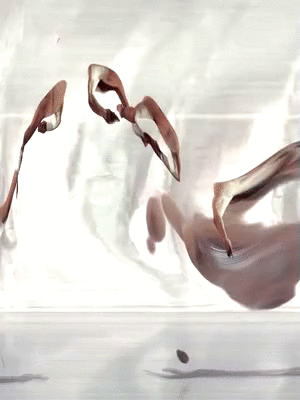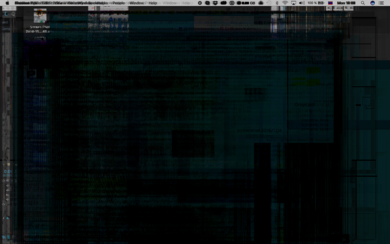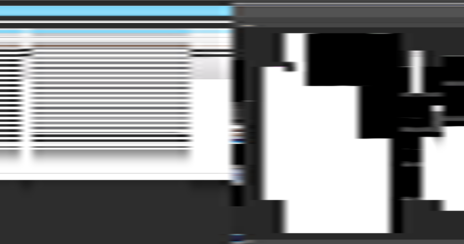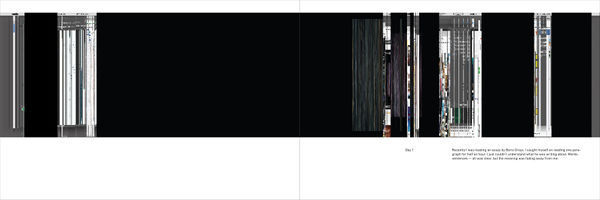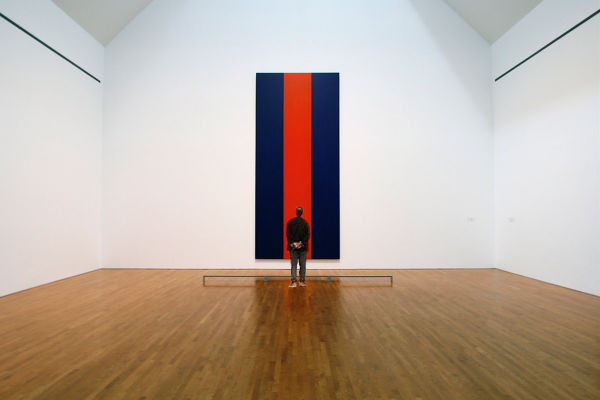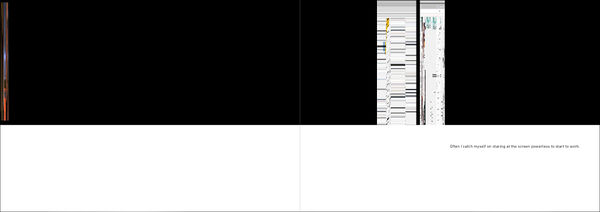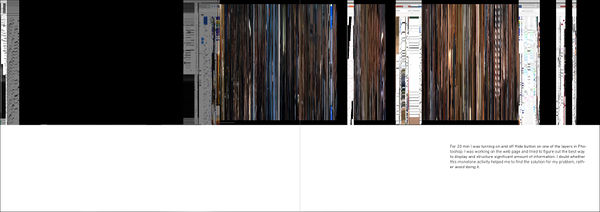User:SN/Graduate proposal: Difference between revisions
No edit summary |
No edit summary |
||
| Line 91: | Line 91: | ||
{{youtube|-4yVbPbJTHc}} | {{youtube|-4yVbPbJTHc}} | ||
{{vimeo|1398634}} | {{vimeo|1398634}} | ||
Revision as of 12:34, 12 June 2017
PREVIOUS PRACTICE
During the two years in PZI my interests revolve around generative art, media specificities and distortion, its inevitability in any digital media.
There are a few features common to all my projects:
- works are based on code
- works are about specificities of different media, transformed and applied one on another
- set of rules directs process
- situations are created in which error could emerge
Untitled, Chain reaction project
Sketch#004, Boundaries of the Archive
PROJECT
“Technologies are artificial, but — paradox again — artificiality is natural to human beings.” (Ong, Orality and Litracy)
Our relationships with the machines, the way technology is changing and overwriting us always were a theme for the discourse. The speculations on this topic can be found in popular culture, scientific articles, cultural and social studies.
Every information technology brings a set of assumptions about the nature of knowledge and intelligence. It becomes subject to criticism, as it fights old established traditions and acquires to develop completely new skills. Nicholas Carr in the essay Is Google Making Us Stupid? wrote: “I’ve had an uncomfortable sense that someone, or something, has been tink- ering with my brain, remapping the neural circuitry, reprogramming the memory. My mind isn’t going – so far as I can tell – but it’s changing. I’m not thinking the way I used to think.”
Tatiana Chernigovskaya is a scientist in the field of neuroscience, psycholinguistics, and theory of mind in one of her lectures said: “We are what we remember”. She points out that memory is not a box with pictures or any other kind of information, not a library or database; our memory is the processes that take place in our brain. These processes are always new. They change who we are, and technology changes them.
- ...
- Recently I was reading an essay by Boris Groys. I caught myself on reading one paragraph for half an hour. I just couldn't understand what he was writing about. Words, sentences — all was clear, but the meaning was fading away from me.
- ....
- Often I catch myself on staring at the screen powerless to start to work. Such moments scare me.
- ...
- This morning I spent few hours checking my Instagram and Facebook accounts. I wrote few comments and put some likes, read articles and watched some videos. I barely remember which photos I commented and what about were my comments. For half an hour I was scrolling my Instagram feed without any attention to content. Just repetitive movements of my finger on the surface of the screen and the void in my memory. I think articles were about new discoveries as some time ago I subscribed to few science magazines and NG. Now is 8 in the evening and I cannot remember any sufficient detail of what I read this morning. This activity didn't bring me joy or satisfaction, yet my morning starts and evening finishes with checking social networks. It became a reflex: you get up, clean your teeth and check the feed on social networks, the mind is not involved.
- ....
- Today I printed out an entire ebook. I cannot concentrate while reading long texts on my Ipad. Reading from the screen takes too much time.
- ...
- For 20 min I was turning on and off Hide button on one of the layers in Photoshop. I was working on the web page and tried to figure out the best way to display and structure significant amount of information. I doubt whether this monotone activity helped me to find the solution for my problem, rather avoid doing it.
These notes I took while dealing with the digital world. Smartphone and laptop have become an essential part of my life. I used to think that they helped me to expedite my work; apps with smart interfaces, plugins, and scripts that opti- mize my workflow. But at some moment these tools stopped to be just tools, I became dependent on them. They transform the way I work, think and feel.
IDEA
In my graduation project, I continued the experiments with generative design that I began in the first year of my studies. In my intention was to gather and analize data to reflect on the theme of the relations between technology and myself, find the best visual expression of the anxiety about losing myself in a digital routine. Taking facts and small things while working on my computer or interacting with my phone, I wanted to reflect on the feeling of being trapped in a digital void.
I started to develop my project being very negative about the impact modern communication technology has on us. Nicholas Carr’s findings only strengthened my assumptions. Nevertheless, now I tend to be less negative. The feelings I want to express are uncertainty and melancholy. I would like to show digital abstract landscape that would carry away in the new environment and evokes contemplation.
FILM
My final piece is a code based animation that recreates data I collect. I used a script that takes screenshots every 10 seconds. It consistently worked in the background while I was using my computer. Python code created “zips” based on these screenshots where black space stands for the time my computer was switched off. It changes as the new digital landscape changes my perseption of time and space.
INSPIRATION AND PROCESS
The main subject of my research was code-based visual systems that I could implement into work with data.
The book is an art book of 100 spreads. Each spread represents digital log and consists of an image and short note. Tentative format 20X30cm, thick paper, and visible board. I want to highlight its materiality, opposed to video projection.
Right now I'm collecting as much data as I can. I have a script that takes screenshots every 10 seconds. It consistently works in the background while I use my computer. I record videos of myself using my laptop front camera. I also collect data about the amount of time I spend in different applications and sites.
I have few sketches of the script. First one works as follows:
Application based on Apple Automator makes screenshots every 10 seconds →
Python code creates cuts based on this screenshots →
I gather cuts in Photoshop to make a final image.
The main subject of my research now is code-based visual systems that I can implement into work with data. I was stuck with certain graphics. So I decided to step back and analyze any changes, patterns, repetitions in data I collect, what they say. Answering this question would help me to find the right way for visualization.
References
Nicholas Carr "The Shallows: How the Internet is Changing the Way We Think, Read and Remember."
Sherry Turkle "Alone Together, The Second Self: Computers and the Human Spirit."
Katherine Hayles "How We Became Posthuman."
Charlie Gere "Digital Culture."
Michael Foucault "Technologies of the Self."
Timothy Barker "Aesthetics of the Error."
Rosa Menkman "The Glitch Momentum."
Casey Reas "Form + Code"
Golan Levin "An Informal Catalogue of Slit-Scan Video Artworks and Research."
Jos de Mul "The Work of Art in the Age of Digital Recombination."
Lev Malovich "Post-media Aesthetics."
Lev Malovich "The Language of New Media."
Mark Hansen "The new Philosophy of New Media."
David Hopkins "After Modern Art."
UPDATE 03_04_2017
MOOD
I've started this project being quite pessimistic. I planned to express anxiety about losing myself in a digital routine, feeling of being trapped in the digital void. Nevertheless, now I tend to be less negative. The feelings I want to express are uncertainty, melancholy, romanization of the “good old non-digital times.” I would like to create a digital abstract landscape that would carry away in the environment it creates, stimulate contemplation, dispose to meditation. My personal notes would play the role of triggers. I'm concentrating on the experience and feelings rather than on certain applications or networks.
Mood reference:
BOOK
I reduced the number of pages in the book. For now, I ended up on 40 spreads (40 images and 40 notes). For 40 days I was thinking, contemplating and analyzing my digital routine, the changes that took place over the last years, my reaction to them. I gathered my thoughts and put them in the book.
The motif of the 40th Day has a symbolic meaning in many cultures. Moses spent forty days and forty nights on Mount Sinai and returned with God's atonement. Besides, 40th Day has major significance in traditions of Eastern Orthodox. It is believed that the soul of the departed remains wandering on Earth during the 40-day period. On 40th day the soul completes the journey finally leaving this world.
VIDEO
Decisions to make:
1. Level of abstraction;
2. Velocity;
3. Sound.
Background: Ambient/noise sound built on graphics.
Main sound: Overlapping voice narratives based on my notes.
Sound "travels" together with the image.






